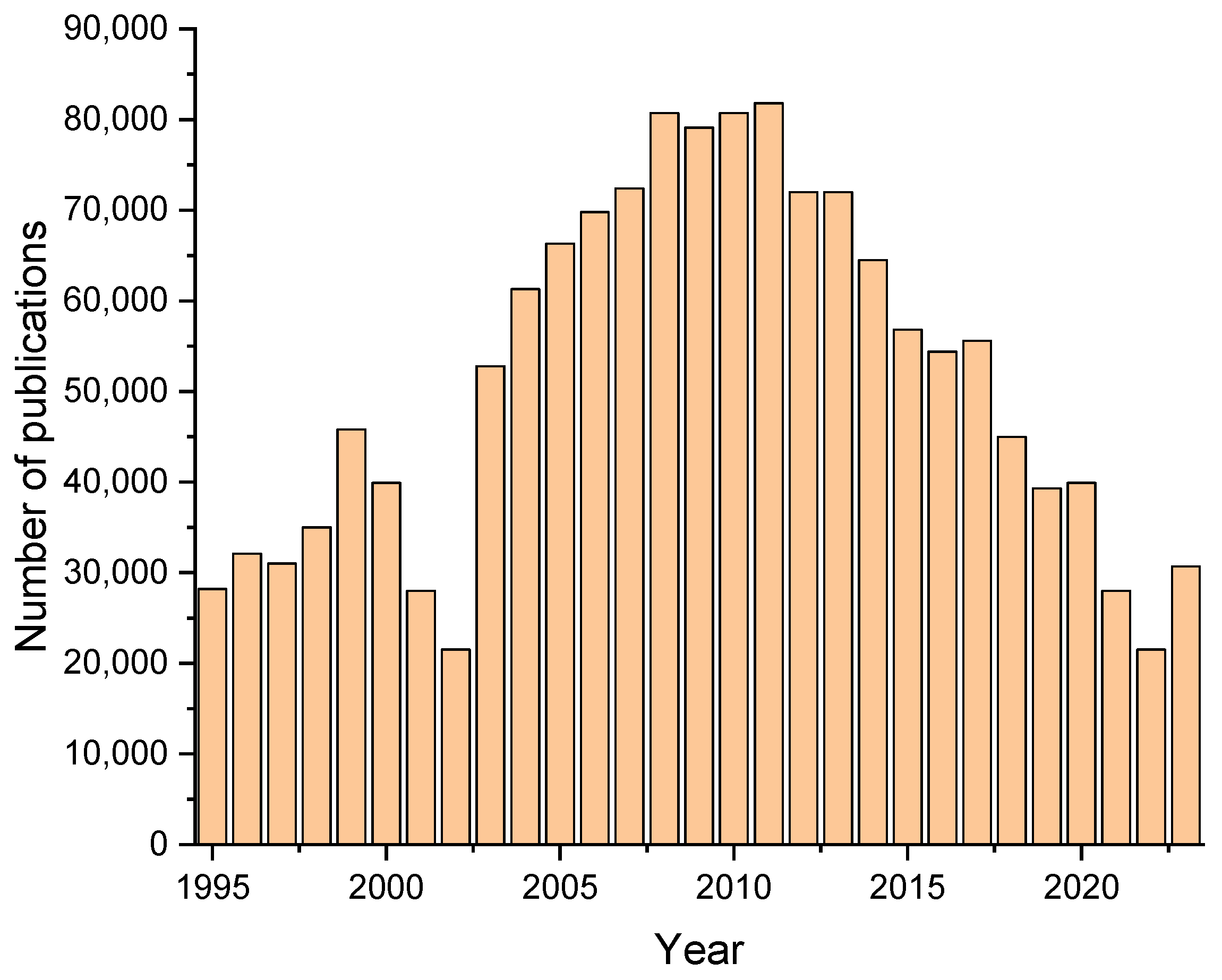Advances in Nanostructured Metallic Materials—A Pathway to Future Innovations
1. Introduction
2. Overview of Recent Developments
3. Addressing Gaps in Knowledge
4. Future Directions for Research
5. Conclusions and Acknowledgments
Author Contributions
Conflicts of Interest
References
- Amzallag, N. From Metallurgy to Bronze Age Civilizations: The Synthetic Theory. Am. J. Archaeol. 2009, 113, 497–519. [Google Scholar] [CrossRef]
- Chirikure, S. The Social Role of Metals. In Metals in Past Societies: A Global Perspective on Indigenous African Metallurgy; Springer: Cham, Switzerland, 2015. [Google Scholar]
- Wang, Y.; Chen, J.; Yang, Y.; Liu, Z.; Wang, H.; He, Z. Nanostructured Superhydrophobic Titanium-Based Materials: A Novel Preparation Pathway to Attain Superhydrophobicity on TC4 Alloy. Nanomaterials 2022, 12, 2086. [Google Scholar] [CrossRef] [PubMed]
- Schaming, D.; Remita, H. Nanotechnology: From the ancient time to nowadays. Found. Chem. 2015, 17, 187–205. [Google Scholar] [CrossRef]
- Khan, N.; Tabasi, Z.A.; Liu, J.; Zhang, B.H.; Zhao, Y. Recent Advances in Functional Materials for Wastewater Treatment: From Materials to Technological Innovations. J. Mar. Sci. Eng. 2022, 10, 534. [Google Scholar] [CrossRef]
- Sharma, A.; Agarwal, P.; Sebghatollahi, Z.; Mahato, N. Functional Nanostructured Materials in the Cosmetics Industry: A Review. ChemEngineering 2023, 7, 66. [Google Scholar] [CrossRef]
- Wojtaszek, K.; Tokarski, T.; Kutyła, D.; Kołczyk-Siedlecka, K.; Żabiński, P.; Csapó, E.; Socha, R.P.; Escribà-Gelonch, M.; Hessel, V.; Wojnicki, M. The Mechanism of Phase Transfer Synthesis of Silver Nanoparticles Using a Fatty Amine as Extractant/Phase Transfer Agent. Metals 2023, 13, 882. [Google Scholar] [CrossRef]
- Shabbir, H.; Csapó, E.; Wojnicki, M. Carbon Quantum Dots: The Role of Surface Functional Groups and Proposed Mechanisms for Metal Ion Sensing. Inorganics 2023, 11, 262. [Google Scholar] [CrossRef]
- Sun, Y.-P.; Zhou, B.; Lin, Y.; Wang, W.; Fernando, K.A.S.; Pathak, P.; Meziani, M.J.; Harruff, B.A.; Wang, X.; Wang, H.; et al. Quantum-Sized Carbon Dots for Bright and Colorful Photoluminescence. J. Am. Chem. Soc. 2006, 128, 7756–7757. [Google Scholar] [CrossRef] [PubMed]
- Patel, J.; Kumar, G.S.; Roy, H.; Maddiboyina, B.; Leporatti, S.; Bohara, R.A. From nature to nanomedicine: Bioengineered metallic nanoparticles bridge the gap for medical applications. Discov. Nano 2024, 19, 85. [Google Scholar] [CrossRef] [PubMed]
- Tao, N.; Lu, K. Dynamic Plastic Deformation (DPD): A Novel Technique for Synthesizing Bulk Nanostructured Metals. J. Mater. Sci. Technol. 2009, 23, 771–774. [Google Scholar]
- Wojtaszek, K.; Skibińska, K.; Cebula, F.; Tokarski, T.; Escribà-Gelonch, M.; Hessel, V.; Wojnicki, M. Synthesis and Catalytic Studies of Nanoalloy Particles Based on Bismuth, Silver, and Rhenium. Metals 2022, 12, 1819. [Google Scholar] [CrossRef]
- Mhd Haniffa, M.A.C.; Ching, Y.C.; Abdullah, L.C.; Poh, S.C.; Chuah, C.H. Review of Bionanocomposite Coating Films and Their Applications. Polymers 2016, 8, 246. [Google Scholar] [CrossRef] [PubMed]
- Sampaio, W.R.V.; Serra, P.L.C.; Dantas, N.O.; de Sousa, R.R.M.; Silva, A.C.A. Nanocomposites Thin Films: Manufacturing and Applications. In Nanocomposite Materials for Biomedical and Energy Storage Applications; Ashutosh, S., Ed.; IntechOpen: Rijeka, Croatia, 2022. [Google Scholar]
- Joo, S.H.; Arnold, R.S.; Luciano, C.M.; Benedict, W.W.; Collins, T. Physicochemical Characteristics of Nanocomposites under Environmental Exposure Conditions for Space Applications. Int. J. Nanoparticles Nanotechnol. 2019, 5, 25. [Google Scholar]
- Baishya, G.; Parasar, B.; Limboo, M.; Kumar, R.; Dutta, A.; Hussain, A.; Phukan, M.M.; Saikia, D. Advancements in nanocomposite hydrogels: A comprehensive review of biomedical applications. Discov. Mater. 2024, 4, 40. [Google Scholar] [CrossRef]
- Wang, L.; Zhang, Z.; Han, X. In situ experimental mechanics of nanomaterials at the atomic scale. NPG Asia Mater. 2013, 5, e40. [Google Scholar] [CrossRef]
- Ramrakhiani, M. Nanostructures and their applications. Recent Res. Sci. Technol. 2012, 4, 14–19. [Google Scholar]
- Kausar, A.; Ahmad, I.; Zhao, T.; Aldaghri, O.; Ibnaouf, K.H.; Eisa, M.H. Graphene Nanocomposites as Innovative Materials for Energy Storage and Conversion—Design and Headways. Int. J. Mol. Sci. 2023, 24, 11593. [Google Scholar] [CrossRef] [PubMed]
- Farooq, N.; Rehman, Z.u.; Khan, M.I.; Asghar, S.; Saleem, M.; Irshad, R.; Sheikh, A.; Shanableh, A.; Manzoor, S.; Khan, Z.U. Nanomaterial-based energy conversion and energy storage devices: A comprehensive review. New J. Chem. 2024, 48, 8933–8962. [Google Scholar] [CrossRef]
- Benavides, B.; Valandro, S.; Kurtz, D. Preparation of platinum nanoparticles using iron(ii) as reductant and photosensitized H 2 generation on an iron storage protein scaffold. RSC Adv. 2020, 10, 5551–5559. [Google Scholar] [CrossRef] [PubMed]
- Xue, Y.; Zhao, H.; Wu, Z.; Li, X.; He, Y.; Yuan, Z. The comparison of different gold nanoparticles/graphene nanosheets hybrid nanocomposites in electrochemical performance and the construction of a sensitive uric acid electrochemical sensor with novel hybrid nanocomposites. Biosens. Bioelectron. 2011, 29, 102–108. [Google Scholar] [CrossRef] [PubMed]
- Główny Urząd Statystyczny. Available online: www.stat.gov.pl (accessed on 9 September 2024).

Disclaimer/Publisher’s Note: The statements, opinions and data contained in all publications are solely those of the individual author(s) and contributor(s) and not of MDPI and/or the editor(s). MDPI and/or the editor(s) disclaim responsibility for any injury to people or property resulting from any ideas, methods, instructions or products referred to in the content. |
© 2024 by the authors. Licensee MDPI, Basel, Switzerland. This article is an open access article distributed under the terms and conditions of the Creative Commons Attribution (CC BY) license (https://creativecommons.org/licenses/by/4.0/).
Share and Cite
Wojnicki, M.; Escribà-Gelonch, M.; Hessel, V. Advances in Nanostructured Metallic Materials—A Pathway to Future Innovations. Metals 2024, 14, 1237. https://doi.org/10.3390/met14111237
Wojnicki M, Escribà-Gelonch M, Hessel V. Advances in Nanostructured Metallic Materials—A Pathway to Future Innovations. Metals. 2024; 14(11):1237. https://doi.org/10.3390/met14111237
Chicago/Turabian StyleWojnicki, Marek, Marc Escribà-Gelonch, and Volker Hessel. 2024. "Advances in Nanostructured Metallic Materials—A Pathway to Future Innovations" Metals 14, no. 11: 1237. https://doi.org/10.3390/met14111237
APA StyleWojnicki, M., Escribà-Gelonch, M., & Hessel, V. (2024). Advances in Nanostructured Metallic Materials—A Pathway to Future Innovations. Metals, 14(11), 1237. https://doi.org/10.3390/met14111237






